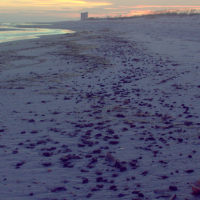Hurricane Isaac Stirred up Tar Balls from BP Spill
 Tarballs on Beach at Bon Secour National Wildlife Refuge, Alabama September 2, 2012 (photo: Greenpeace)
Tarballs on Beach at Bon Secour National Wildlife Refuge, Alabama September 2, 2012 (photo: Greenpeace)
Although Hurricane Isaac killed several people and caused $1.5 billion in property damage, it had the salutary effect of putting the lie to oil giant BP’s frequent claims that the effects of its Deepwater Horizon oil spill are over and done. The powerful storm exposed oil buried along Gulf Coast beaches, oil that BP failed to clean up after the April 2010 spill, the worst in American history. The accident that caused the spill killed 11 workers.
Since the storm passed and the waters receded, tar balls, tar mats and oil have been found on the beaches of Alabama, Louisiana and Mississippi, mostly in places where heavy oil deposits occurred during the spill. The oil forced officials to close a 13-mile stretch of Fourchon beach in Louisiana Tuesday, where a dead whale washed up and officials have banned commercial fishing within one mile of shore. Isaac made landfall near Fourchon August 28 as a Category 1 storm.
Garret Graves, Louisiana Gov. Bobby Jindal’s top coastal aide, accused BP of failing to pursue its initial cleanup efforts aggressively enough. “If they would put just a fraction of the dollars they’re putting into their PR campaign into cleanup, we’d certainly be much farther ahead than we are now,” he complained.
Although BP admits that some of the oil comes from its spill, it also claims that some of the crude may come from elsewhere.
Edward Overton, a chemist and oil spill expert at Louisiana State University, said that although the oil was weathered and less toxic than it was two years ago, it could still hurt animals like crabs, crawfish and bait fish. He also confirmed that, based on the oil’s chemical “fingerprint,” at least some, and probably most, of the oil fouling the coast did come from the BP oil spill.
Alabama officials believe the tar covering their beaches was coming from large, underwater mats that formed after the spill. “I do believe we are going to be dealing with this for years,” said Grant Brown, a spokesman for the city of Gulf Shores, Alabama.
-Matt Bewig
- To Learn More:
How Scientists Know the Tar Balls Hurricane Isaac Dredged Up Came From the BP Oil Spill (by Colin Schultz, Smithsonian Magazine)
Oil from BP Spill Uncovered by Isaac’s Waves (by Cain Burdeau and Jay Reeves, Associated Press)
BP Sending Gulf Coast Chefs to Olympics to Tout Louisiana Cuisine It Destroyed (by Matt Bewig, AllGov)
- Top Stories
- Unusual News
- Where is the Money Going?
- Controversies
- U.S. and the World
- Appointments and Resignations
- Latest News
- Trump to Stop Deportations If…
- Trump Denounces World Series
- What If China Invaded the United States?
- Donald Trump Has a Mental Health Problem and It Has a Name
- Trump Goes on Renaming Frenzy






Comments